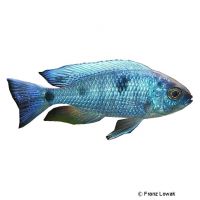Chrysonotus Cichlid (Copadichromis chrysonotus)
| Chrysonotus Cichlid Copadichromis chrysonotus | |
|---|---|
| Name | Chrysonotus Cichlid |
| Name Lat. | Copadichromis chrysonotus |
| Synonym | Haplochromis chrysonotus |
| Family | Cichlids |
| Family lat. | Cichlidae |
| Order | Cichlids |
| Order lat. | Cichliformes |
| Origin | Lake Malawi |
| Habitat | Open water |
| Diet | Planktivore |
| pH | 7.5-8.8 |
| Behavior | Peaceful |
| Keeping | Harem |
| Care Level | Moderate |
| Reproduction | Mouthbrooder |
| Breeding | Simple |
| Life Span | 6-10 years |
| Protection | No |
| Metric Units | |
| Size | 13-15 cm |
| Temperature | 24-28 °C |
| Hardness | 10-25 °dH |
| Aquarium | ~ 400 l |
| US Units | |
| Size | 5"-6" |
| Temperature | 75-82 °F |
| Hardness | 178-445 ppm |
| Aquarium | ~ 100 gal |
Distribution and habitat
Chrysonotus Malawi cichlids are found exclusively (endemically) in Lake Malawi, where they are widespread throughout the lake. They live in the near shore open water of the large rocky transition zone (rock littoral) with sandy bottoms. In their range there are some differently colored site variants.
Maintenance
The aquarium setup should have rocky structures reaching to the water surface, with plenty of crevices, caves and shelters to provide hiding places, as well as robust plants, some free sand areas and plenty of free swimming space.
No ammonia, ammonium or nitrite should be detectable, and the nitrate value should not exceed 100 mg/l. To ensure the water quality and the oxygen content, a filter adapted to the aquarium size and a heater are required, as well as lighting for the species-appropriate day-night rhythm of the animals.
Diet
In nature they feed mainly on plankton. The food supply consists of dry, frozen and live food. For a balanced diet, feed once a day with a high-quality dry food for Malawi cichlids (flakes, granules, pellets) as well as cyclops, daphnia, artemia, mosquito larvae and plankton (live or frozen)
It is recommended to feed small portions several times a day. Only feed as much as will be eaten within a few minutes. A regular and varied diet promotes health and increases resistance.
Behaviour and compatibility
They should be kept in a harem, one male with several females. The males behave territorially at spawning time, so keeping several harems is only recommended in a larger and richly structured tank. They belong to the more peaceful Malawi cichlids and should only be socialized with other peaceful cichlids.
Basically, only compatible fish species with similar demands on water conditions and water temperature should be socialized.
Sex dimorphism
The animals differ clearly in coloration (sexual dichromatism). The male is much more colorful, has longer extended fins and some egg spots on the anal fin. The female is smaller and inconspicuous silvery colored.
Reproduction and breeding
Maternal mouthbrooders are the only Malawi cichlid species to spawn in open water. The males occupy a territory in open water and court passing females. Immediately after spawning, these pick up the eggs, which sink slowly to the bottom, in their throat sac for mouthbrooding, where they are fertilized by the male. They retain the fry in their throat sac even after hatching and release them after about 3 weeks. During the entire brood care the female does not take any food.
Fry must be fed several times a day with special rearing food. Breeding is possible in community tanks, as the fry are relatively large after release.
Important
They belong to the Utaka cichlids, which at times inhabit the plankton-rich open water zone in front of rocks and reefs near the shore in swarms
Different site variants should not be kept together, as crossbreeding (hybridization) can occur
The well-being of the fish should be monitored regularly. Temperature should be checked daily, pH, hardness and nitrate levels at least fortnightly. Regular partial water changes are recommended, even if the contaminant level has not yet reached the upper limit. Sudden changes in water quality should be avoided. Newly introduced fish must be accustomed slowly to the water in the aquarium.
Further literature can be found in your pet store.
References
Text: Werner Winter; Image: Franz Lowak
Source: BMELV (1998): Tierschutzgutachten - Haltung von Zierfischen (Süßwasser); RIEHL & BAENSCH (2006): Aquarien Atlas Bd. 1, Mergus Verlag; ENGELMANN (2005): Zootierhaltung - Tiere in menschlicher Obhut: Fische, Verlag Harri Deutsch
- Gemäß § 21 Abs. 5 Tierschutzgesetz idgF
